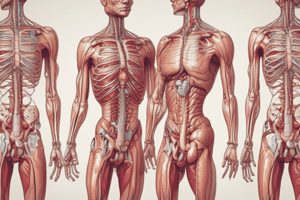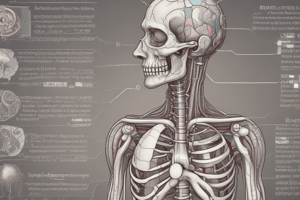Podcast
Questions and Answers
What are the primary structural units of all living organisms?
What are the primary structural units of all living organisms?
- Molecules
- Tissues
- Cells (correct)
- Atoms
Which of the following best describes biological science?
Which of the following best describes biological science?
- Study of living organisms and their interactions (correct)
- Study of physical phenomena
- Study of geological formations
- Study of chemical reactions in non-living substances
What is the difference between prokaryotic and eukaryotic cells?
What is the difference between prokaryotic and eukaryotic cells?
- Eukaryotic cells are generally smaller than prokaryotic cells.
- Prokaryotic cells lack a nucleus, while eukaryotic cells have a nucleus. (correct)
- Prokaryotic cells have membrane-bound organelles, eukaryotic cells do not.
- Eukaryotic cells reproduce asexually, prokaryotic cells reproduce sexually.
Biology is derived from which two Greek words?
Biology is derived from which two Greek words?
Which of the following levels of organization represents a collection of similar cells forming a specific function?
Which of the following levels of organization represents a collection of similar cells forming a specific function?
Which field of study focuses on the structure of organs?
Which field of study focuses on the structure of organs?
What does microbiology study?
What does microbiology study?
Which branch of biology is concerned with the study of heredity?
Which branch of biology is concerned with the study of heredity?
Which field studies the classification of plants and animals?
Which field studies the classification of plants and animals?
Which field examines the functions and activities of living organisms?
Which field examines the functions and activities of living organisms?
What is the focus of embryology?
What is the focus of embryology?
Which discipline studies the mechanisms of diseases?
Which discipline studies the mechanisms of diseases?
What is the main benefit of studying biology?
What is the main benefit of studying biology?
Which characteristic of living organisms involves the ability to respond to environmental changes?
Which characteristic of living organisms involves the ability to respond to environmental changes?
What is the main focus of the cell and tissue biology courses described?
What is the main focus of the cell and tissue biology courses described?
According to the modern cell theory, what is true about all known living things?
According to the modern cell theory, what is true about all known living things?
Which system is responsible for the process of excretion in living organisms?
Which system is responsible for the process of excretion in living organisms?
What proportion of the total assessment does the final theoretical exam comprise?
What proportion of the total assessment does the final theoretical exam comprise?
Which aspect of living organisms is primarily related to the respiratory system?
Which aspect of living organisms is primarily related to the respiratory system?
Which of the following processes is considered a characteristic of nutrition in living organisms?
Which of the following processes is considered a characteristic of nutrition in living organisms?
Which assessment task has the least weight towards the total assessment?
Which assessment task has the least weight towards the total assessment?
Which statement accurately describes eukaryotic cells?
Which statement accurately describes eukaryotic cells?
What is the typical size range for prokaryotic cells?
What is the typical size range for prokaryotic cells?
Which of the following characteristics distinguishes prokaryotic cells from eukaryotic cells?
Which of the following characteristics distinguishes prokaryotic cells from eukaryotic cells?
Which method of cell division is associated with eukaryotic cells?
Which method of cell division is associated with eukaryotic cells?
Which of the following is true about the DNA structure in eukaryotic cells?
Which of the following is true about the DNA structure in eukaryotic cells?
Which statement about living cells is correct?
Which statement about living cells is correct?
What is the primary structural and functional unit of all living organisms?
What is the primary structural and functional unit of all living organisms?
Which of the following correctly describes prokaryotic cells?
Which of the following correctly describes prokaryotic cells?
Which of the following is NOT a characteristic of eukaryotic cells?
Which of the following is NOT a characteristic of eukaryotic cells?
What is the sequence of organization from cells to organisms?
What is the sequence of organization from cells to organisms?
Which of the following statements about DNA is true?
Which of the following statements about DNA is true?
What is the function of tissues in living organisms?
What is the function of tissues in living organisms?
Which of these is a feature of both prokaryotic and eukaryotic cells?
Which of these is a feature of both prokaryotic and eukaryotic cells?
Flashcards are hidden until you start studying
Study Notes
Introduction to Biology
- Biology is the scientific study of life, encompassing the structure, function, and relationships of living things.
- It is a branch of natural science that examines the characteristics, organization, and interactions of living organisms.
- Medical biology specifically focuses on the study of human biology.
Importance of Biology
- Understanding ourselves and our surroundings.
- Recognizing how living things interact with their environment.
- Appreciating the diverse array of life on Earth.
- Gaining insights into human body functions.
- Facilitating disease diagnosis, particularly through microscopic examination.
- Contributing to the discovery of cures for diseases.
- Enhancing our understanding of genetic mechanisms.
Fields of Study within Biology
- Anatomy: Examines the structure of organs.
- Embryology: Studies the development of embryos.
- Histology: Focuses on cells and tissues.
- Genetics: Investigates heredity.
- Microbiology: Explores microorganisms.
- Virology: Focuses on viruses.
- Mycology: Studies fungi.
- Bacteriology: Investigates bacteria.
- Physiology: Examines the functions and activities of living organisms.
- Taxonomy: Classifies plants and animals.
- Biochemistry: Studies biochemical processes within the body.
- Parasitology: Examines parasites.
- Zoology: Studies animals.
- Botany: Studies plants.
Cell Theory
- All living organisms are composed of one or more cells (unicellular or multicellular).
- All living cells arise from pre-existing cells through division.
- The cell is the fundamental structural and functional unit of all living organisms.
- Energy flow (metabolism and biochemistry) occurs within cells.
- Cells contain DNA, specifically in chromosomes located in the nucleus, and RNA in both the nucleus and cytoplasm.
Organization Levels of Living Organisms
- Cells: The basic building blocks of life.
- Tissues: Groups of similar cells that work together to perform a specific function. There are four primary tissue types in the body.
- Organs: Structures composed of different tissue types that work together to perform a specific function.
- Systems: Groups of organs that work together to carry out a major bodily function.
- Organisms: Individual living beings composed of multiple systems.
Types of Cells
Prokaryotes
- Relatively small cells (1-5 μm) with a simple structure.
- Surrounded by a plasma membrane and a cell wall.
- Lack a nucleus; genetic material is in the form of circular or linear DNA free in the cytoplasm.
- Lack membranous organelles; only non-membranous ribosomes are present.
- Examples: Bacteria.
Eukaryotes
- Larger and more complex cells (10-100 μm).
- Possess a nucleus containing organized genetic material and numerous organelles.
- Can be unicellular or multicellular.
- Surrounded by a plasma membrane.
- Have distinct nuclei enclosed by a nuclear membrane or envelope.
- Examples: Plants, fungi, animals, and humans.
Differences between Eukaryotic Cells and Prokaryotic Cells
| Feature | Eukaryotic Cells | Prokaryotic Cells |
|---|---|---|
| Size | Larger & complex (>5 μm) | Small & simple (1-5 μm) |
| Nucleus | Visible with low power | No Nucleus |
| DNA | Present in the nucleus, bound by histone protein | Free in cytoplasm |
| Organelles | System of organelles (membranous & non) | No membranous organelles |
| Ribosomes | Present | Only ribosomes (non-membranous) |
| Division | Mitosis & meiosis | Simple fission |
| Examples | Animals & human | Bacteria |
Studying That Suits You
Use AI to generate personalized quizzes and flashcards to suit your learning preferences.




